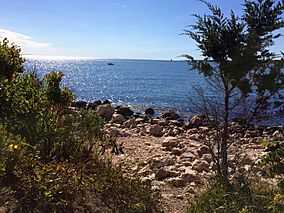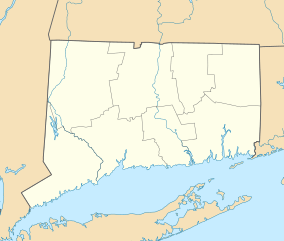Bluff Point State Park facts for kids
Quick facts for kids Bluff Point State Park |
|
|---|---|

Bluff Point view of Fisher's / Long Island Sound with Fisher's Island (left) and the New London Ledge Lighthouse (right) visible on the horizon.
|
|
| Location | Groton, Connecticut, United States |
| Area | 806 acres (326 ha) |
| Elevation | 108 ft (33 m) |
| Designation | Connecticut state park |
| Established | 1963 |
| Administrator | Connecticut Department of Energy and Environmental Protection |
| Website | Bluff Point State Park |
Bluff Point State Park is a special place in Groton, Connecticut. It's a public park and nature preserve on a piece of land that sticks out into Long Island Sound. This park is unique because it's one of the last undeveloped shorelines in Connecticut.
The park covers about 806 acres. It has sandy beaches, tall cliffs, forests, and wet areas where the ocean tides come in. A big part of the park, 778 acres, is a protected coastal reserve. This means it's kept very natural to protect the plants and animals that live there. People can visit Bluff Point for hiking, biking, boating, and fishing. The Connecticut Department of Energy and Environmental Protection takes care of the park.
Contents
A Look Back: The History of Bluff Point
Who Lived Here First?
Long ago, the Pequot people used Bluff Point. They gathered seafood here before Europeans arrived in America.
Early Farms and Families
In 1649, a large area of land, including what is now Bluff Point, was given to John Winthrop the Younger. This land was called Winthrop's Neck. Over time, it was split into different farms.
Around 1712, a farmhouse called Winthrop House was built on Bluff Point. It was a working farm with blackberry bushes and apple trees. You can still see the old foundations of the farmhouse today! In the early 1900s, parts of Bluff Point were even used to grow potatoes.
Summer Fun and a Big Storm
In the early 1900s, Bluff Point became a popular spot for summer vacations. People started camping there in the 1910s. By the 1930s, many small summer cottages had been built.
However, the land owner decided to stop renting out the property in 1938. Before people could protest, nature stepped in. On September 21, 1938, a huge hurricane hit the coast. It destroyed almost all 106 homes on the site. Only the old Winthrop farmhouse was left standing.
Protecting Bluff Point
People started suggesting Bluff Point should be a state park as early as 1914. In 1963, the state of Connecticut bought a large part of Bluff Point. They wanted to protect it because it was the "last remaining significant portion of undeveloped shoreline in Connecticut."
In 1975, the Connecticut legislature made Bluff Point a Coastal Reserve. This gives it the highest level of protection in the state park system. This protection helps keep the park safe for the many rare and endangered plants and animals that live there.
Local Legends
There's a story about a big rock on the beach called Split Rock. Legend says it suddenly split in January 1780 with a sound like a cannon. Scientists think it probably split because freezing water expanded in a crack in the rock.
Another spot, Sunset Rock, was used by the summer community for meetings and church services. Sadly, you can't see the sunset from this rock anymore.
Amazing Plants and Animals
Bluff Point is home to many different kinds of plants and animals. This is because it has a mix of habitats, like salt marshes, coastal forests, sand dunes, and grassy areas under the water.
Birds Galore!
The park is a fantastic place for bird watching! More than 200 different types of birds have been seen here. You might spot many kinds of gulls, shorebirds, and other land birds, including some rare ones.
Land and Sea Creatures
On land, you might see common animals like deer, coyotes, foxes, rabbits, raccoons, and opossums. In the water, there are horseshoe crabs, clams, mussels, snails, and many different types of crabs and lobsters.
What Can You Do at Bluff Point?
Bluff Point State Park offers lots of fun activities:
- Bird Watching: With over 200 species, it's a bird watcher's paradise!
- Picnicking: Enjoy a meal outdoors with beautiful views.
- Fishing: You can go saltwater fishing for striped bass, sea trout, bluefish, and summer flounder.
- Shell Fishing: Look for clams and mussels.
- Hiking: Explore the many trails throughout the park.
- Horseback Riding: Some trails are open for horseback riding.
- Mountain Biking: Ride your bike on designated trails.
- Boating: There's a ramp for launching small boats.



